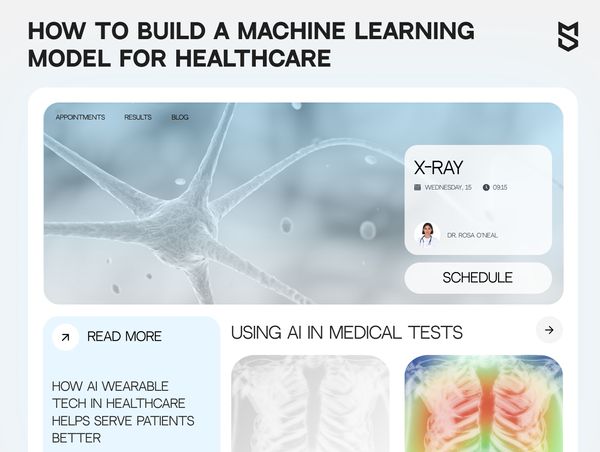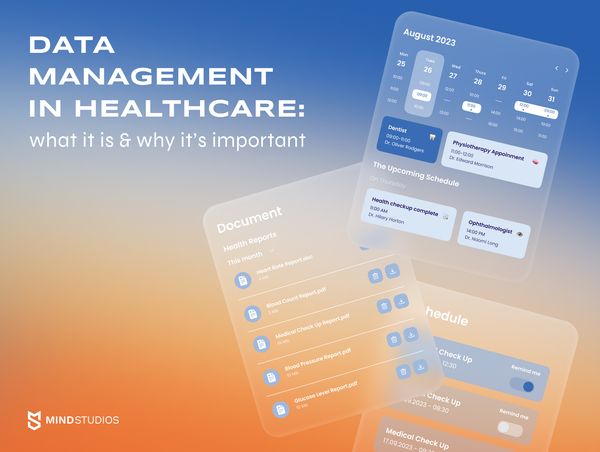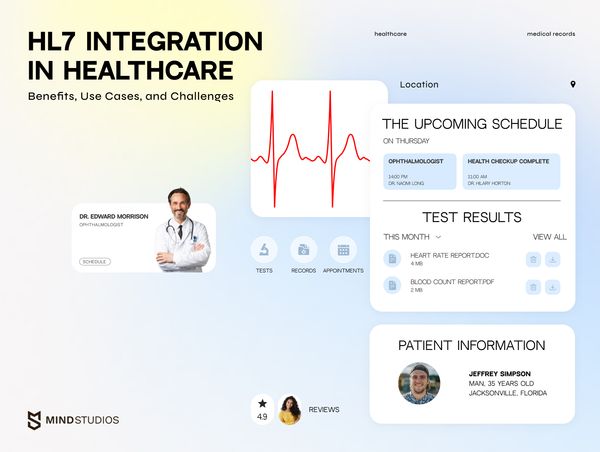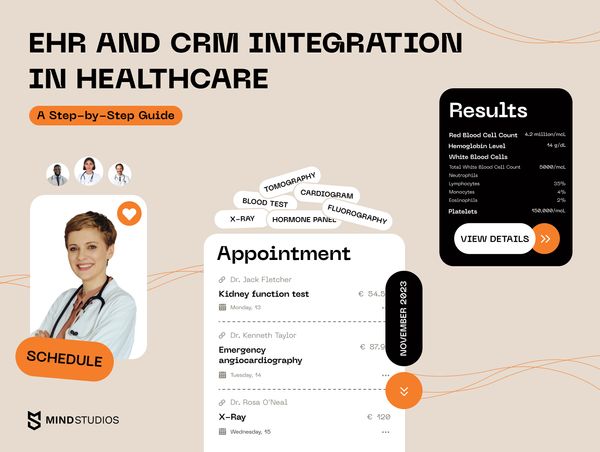
EHR and EMR systems in medical settings resemble having a comprehensive GPS for patient care: they provide real-time directions, helping healthcare professionals find the most efficient route to the patient’s well-being. These systems enable medical workers to efficiently manage and access patient medical records, enabling more informed and streamlined care delivery. In the USA, hospitals are choosing Epic API integration for these purposes.
According to a report published in May 2023, nearly 36% of the acute care hospitals in the country are using Epic systems. Moreover, the company holds 47.6% of hospital beds in the US hospitals. The system provides highly customizable and integrated EHR/EMR solutions that facilitate seamless communication, collaboration, and data sharing among healthcare providers.
While developing digital platforms for our clients in the healthcare industry, Mind Studios has also found Epic to offer some of the most efficient EHR and EMR systems on the market. As self-proclaimed ambassadors of the solution, we created this article to tell you about the opportunities Epic presents, guide you through the integration process, and share tips we learned while working with it.
What are Epic EHR and EMR systems?
Today, over 2,300 hospitals listed on Hospital View use Epic EHRs. The company handles the records of over half of the patients in the USA, employs nearly 10 thousand people, and successfully competes with corporations like Google, Microsoft, and Apple. But it all started in 1979 in a basement with just two people and their aspiration to move patient records from dusty folders to digital records.
Judy Faulkner, a software engineer and the brain behind Epic managed to evolve the product from software for academic medical centers to comprehensive Electronic Health Record (EHR) and Electronic Medical Record (EMR) systems.
Today, Epic offers EMR and EHR systems that help healthcare organizations digitize and centralize patient health information. EHRs encompass a comprehensive patient health record collected from different healthcare settings and timeframes, providing a holistic view of a patient's medical history and care. EMRs, on the other hand, are typically limited to clinical data within just one healthcare organization.
Here is a comparison list to give you a better understanding of the difference between these two systems.
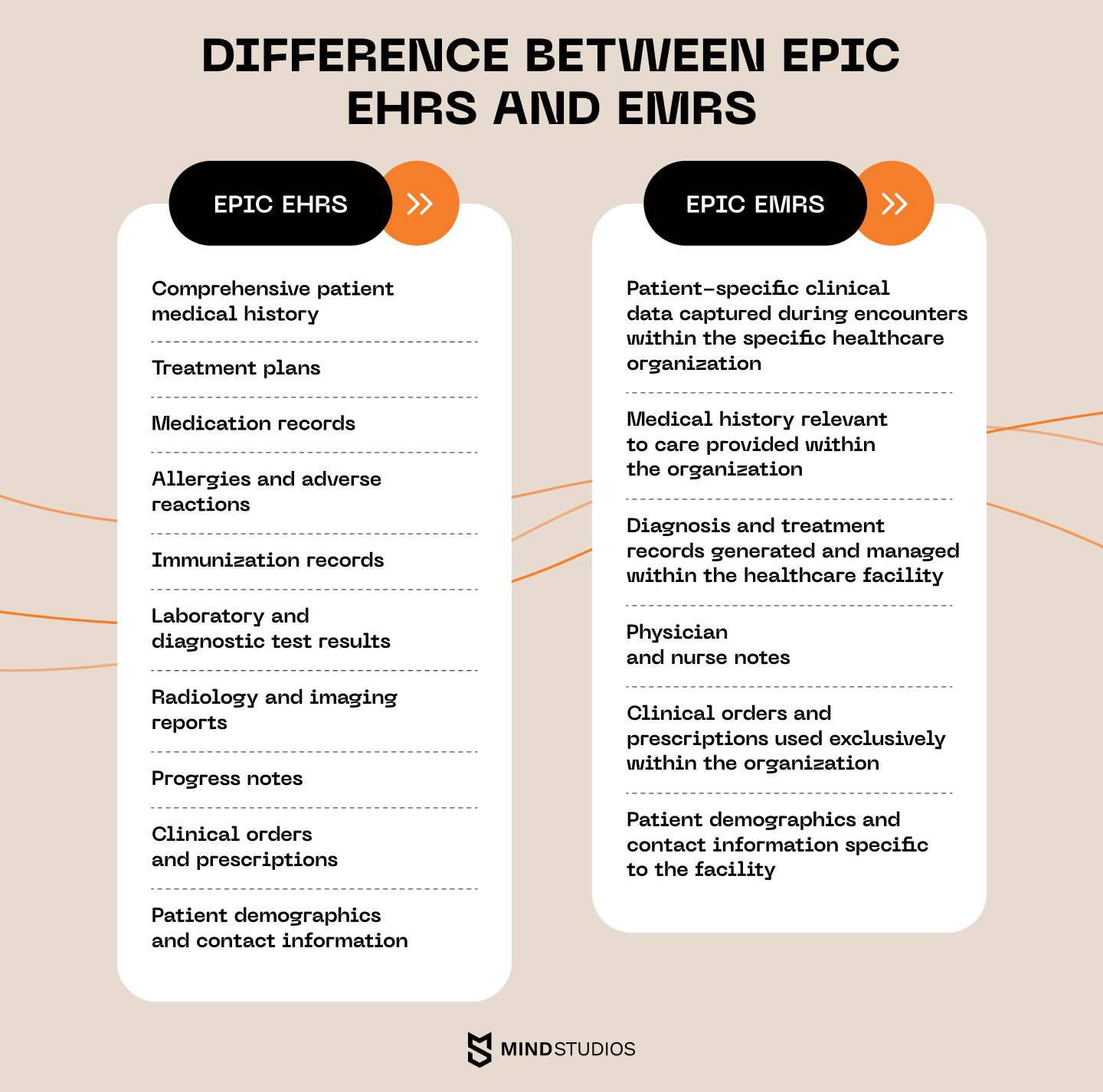
Why do healthcare facilities and HealthTech companies choose Epic?
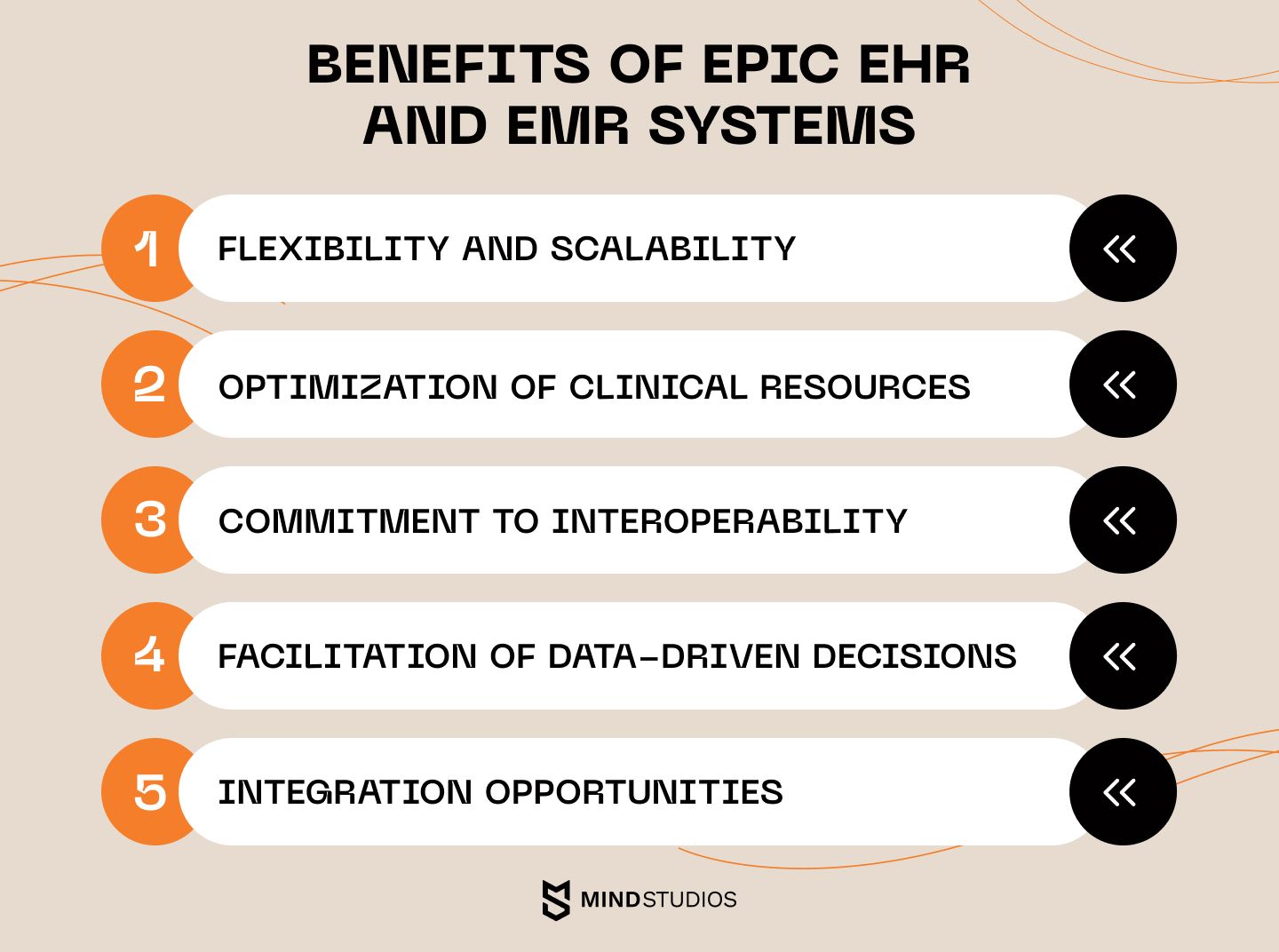
Organizations and businesses in healthcare opt for Epic EHR and EMR systems for many reasons. The most compelling of them include:
Flexibility and scalability
Epic software caters to the diverse needs of healthcare organizations of all sizes, enabling them to scale through their modular, customizable architecture. For instance, healthcare facilities can choose the specific system components they need. As a result, small clinics can start with a basic setup and add more modules as they grow, while large hospitals can deploy a comprehensive set of features.
Optimization of clinical resources
Epic EHR/EMR systems help streamline administrative and clinical workflows by automating repetitive tasks. Moreover, Epic's integrated clinical data and decision support tools enable clinicians to access patient records swiftly, leading to faster diagnosis and treatment decisions. All of this helps optimize time and resource utilization.
Commitment to interoperability
Epic system embraces industry standards like HL7 (Health Level 7) and FHIR (Fast Healthcare Interoperability Resources) for seamless data exchange between external healthcare systems, eliminating data silos and facilitating collaborative care. This enables organizations to easily share patient data with other healthcare providers, labs, and third-party applications.
Facilitation of data-driven decisions
Epic’s advanced reporting and analytics tools allow healthcare facilities to leverage data for informed decision-making, enhancing operational efficiency. For instance, by using the system for resource utilization, a hospital can optimize staffing levels based on peak admission hours. In addition to benefiting the hospital, this ensures that patients receive proper and timely care.
Integration opportunities
Epic is known for its open architecture and use of industry standards. To be more specific, it offers APIs and web services that enable seamless connectivity with external systems and applications. Epic EMR API, EHR API, and the support for integration standards like HL7 and FHIR make it easier for healthcare organizations to develop custom integrations and leverage third-party solutions, creating an interconnected software ecosystem. We’ll dive more into the matter in the next section.
Epic integration process
Getting to the main point of the article, we have to address one crucial issue. What ways are there to integrate Epic? And which of them is the most efficient?
To cut a long story short, the choice of integration approach depends heavily on the existing software's architecture, Epic's compatibility with it, the customization level required, and the long-term objectives of the organization.
As a rule, organizations choose between HL7, FHIR, and API-based integration. Let’s go over each of these options quickly.
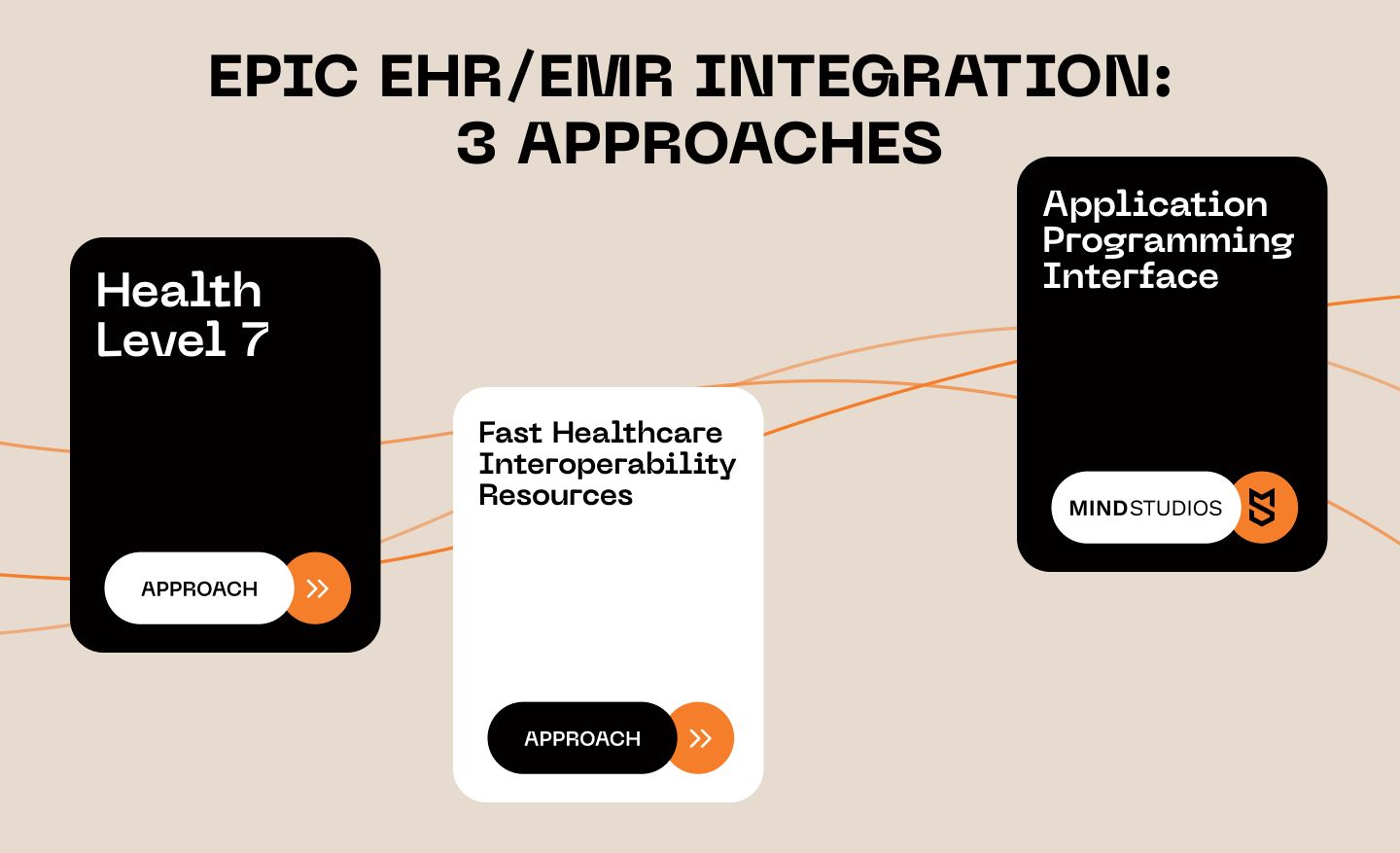
Health Level 7
HL7 is a widely used standard for healthcare data exchange and involves creating HL7 messages that conform to a predefined schema for data transfer between systems. The option is cost-effective but mostly suitable for well-defined data structures. In this case, HL7 can cover the exchange of standardized patient demographic data, appointment scheduling information, and clinical messages with external systems.
Fast Healthcare Interoperability Resources
FHIR offers modern and flexible functionality, leveraging standard data formats and API endpoints and simplifying data exchange between Epic and other systems. It’s suitable for cases when the goal is to create interoperable, shareable health records and enable patient access to their data via mobile apps and wearables.
Application Programming Interface
API-based Epic integration is the optimal choice for organizations that require custom, real-time data exchange and the flexibility to connect with diverse external systems. The option requires more development effort but caters to unique data-sharing needs and enables rapid information exchange, adaptability to technology standards, and seamless scaling.
Mind Studios is primarily focused on creating highly customizable solutions. Therefore, in the step-by-step guide below, we provided a comprehensive overview of the Epic API integration process.
Phase |
Process |
|---|---|
Project planning |
Comprehensive planning is the foundation of the project. This stage involves
|
Creating an account on Uscdi.epic.com and accessing data |
Integrating existing software with Epic involves using the system’s API. For this, an organization needs to create an account on the Epic UserWeb, specifically on the Clinical Exchange Platform (CExP). This account grants access to Epic's tools and resources necessary for EHR/EMR integration. The registration process starts on Uscdi.epic.com and involves:
When the account is approved, you can access documentation, development tools, support materials, and other resources essential for the integration process. At this point, it’s also essential to confirm that your software can access all necessary data by checking the available endpoints. After that, you can obtain the API key and test all endpoints to ensure proper functionality using REST (Representational State Transfer) clients. |
Testing and validation |
This next stage requires software developers and QA engineers to ensure the integration works seamlessly and complies with healthcare standards. The process consists of:
|
Connecting and deployment |
After testing, it’s time to connect everything and go live. This phase involves setting up secure data transfer protocols, incorporating API calls with relevant endpoints, customizing the integration to align with the specific workflow, and more. Before going live, it’s also essential to provide training and support to the staff who will use the system. |
Support and optimization |
Even when the system goes live, the job is not over. To make it reliable and effective, it’s crucial to:
|
If you have any questions left on how to integrate with Epic EHR and EMR systems, don’t hesitate to reach out, and our team will happily guide you through the process.
Challenges and solutions
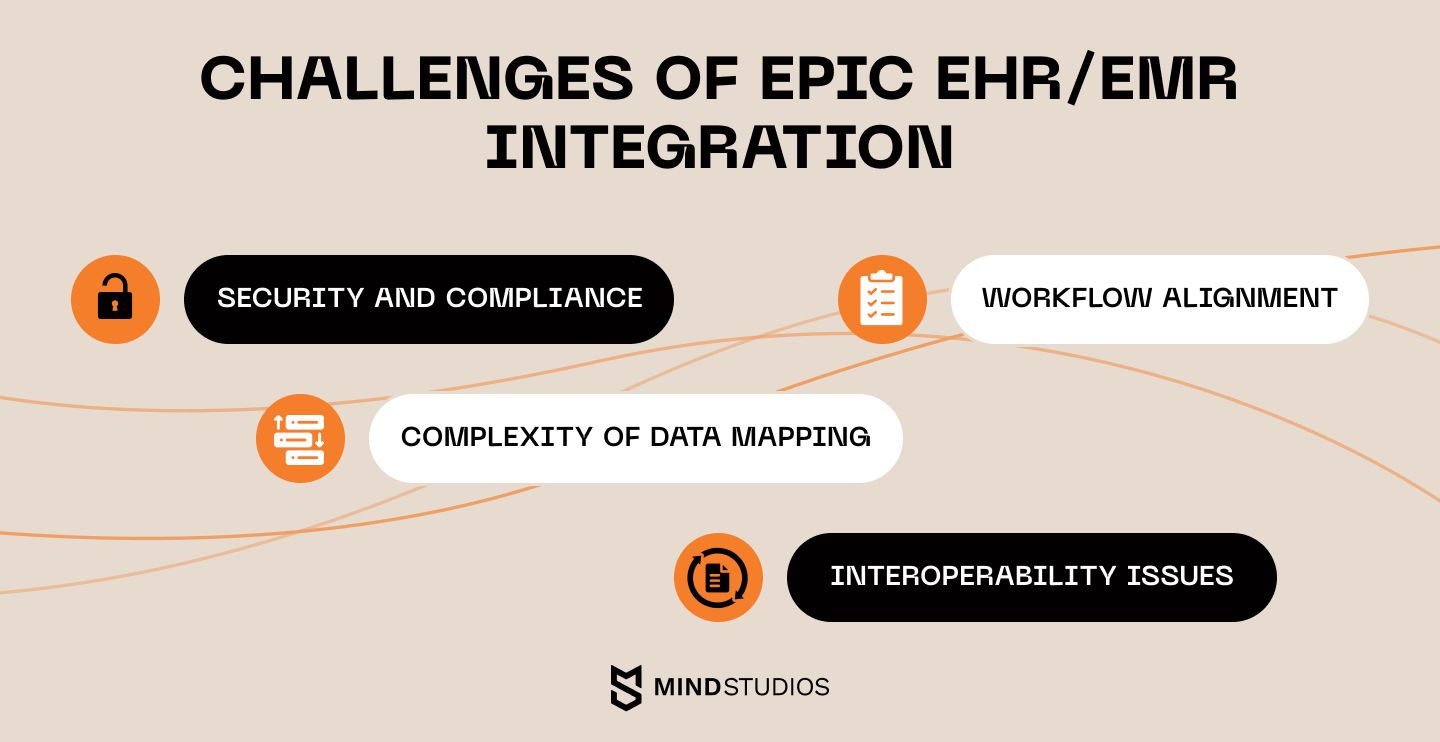
Epic EHR and EMR systems are incredibly complex; therefore, it’s only natural that integrating them into software comes with a number of challenges. In this section, we explore the most common issues and discuss best practices for overcoming them.
Security and compliance
Organizations that handle patient records are obligated to protect this highly sensitive data and adhere to healthcare regulations like HIPAA. For this, healthcare organizations must implement strong data encryption, access control measures, and audit trails to ensure data security during integration. Additionally, it’s crucial to conduct regular security assessments and vulnerability testing, as well as provide staff training on security and compliance requirements.
If you are looking for tips on building healthcare solutions compliant with regulatory requirements, check out our article about HIPAA-compliant software development.
Complexity of data mapping
Epic systems typically have intricate data structures, which makes it difficult to map and align data from external sources accurately. In some scenarios, this challenge can result in data discrepancies and errors.
To ensure smooth data translation between systems, organizations should invest in robust data mapping tools, create clear data mapping documentation, and embrace data standardization practices.
Interoperability issues
Epic systems need to be connected with a wide range of external healthcare applications, which may not share the same data standards. To ensure proper cross-platform data exchange, organizations should adhere to standardized data exchange protocols, such as HL7 and FHIR. Additionally, it can be helpful to implement middleware solutions that can translate and bridge data between Epic and other systems.
Workflow alignment
When integrating EHRs and EMRs, organizations must ensure their daily operations align smoothly with Epic's systems. Otherwise, the integration may cause disruptions and thus hinder the system's adoption.
To tackle this challenge, it makes sense to conduct a thorough analysis of the current workflows and develop a plan for aligning them with Epic's processes. The plan should cover training the personnel on using Epic’s EHR/EMR software, gathering feedback, and adjusting the systems to the organization's needs.
To sum up, these challenges bear potential threats to seamless, secure, and effective Epic EHR integration and EMR implementation. However, every single issue on this list is fairly simple to deal with if you collaborate closely with a skilled tech team that has the expertise to work with Epic systems.
Epic’s impact on the healthcare system
Epic’s primary clients are large US-based healthcare facilities. Between 2017 and 2022, the company gained 434 hospitals and added 94,656 beds to their system. In 2022, Epic held 35.9% of the hospital market share among EHR vendors.
The USA is not the only country where Epic has gained traction. According to KLAS Research, in 2023, Epic’s EpicCare Inpatient EMR became the winning provider of acute care EMR in Canada and Europe.
Some of the top hospitals and health systems using Epic include Cleveland Clinic, UCLA Health, Mayo Clinic, NewYork-Presbyterian, and Stanford Hospital. To give you an idea of how significant these clients are, Mayo Clinic spent $1.5 billion to integrate all patient health records into the Epic EHR system. The reason for this overwhelmingly big budget is simple: the Mayo Clinic health system employs over 70 thousand people and serves over 600,000 patients each year.
In an interview for CBS News, Dr. Steve Peters, a pulmonary critical care physician at Mayo Clinic, was asked what switching to Epic means for the organization. The doctor explained:
“We've been keeping track of the diagnoses of the Mayo Clinic patients since before we had electronic records. But the ability to have it all coming from one source makes it a lot easier. Without good access to data, you really are flying blind.”
Even though data entry into the Epic EHR system can feel time-consuming, Dr. Peters believes that it’s just something medical professionals have to do for now. Besides, Epic is currently working on an "Alexa of medical records", a solution that would allow doctors to use voice commands for faster and more efficient data entry.
It’s worth noting that hospitals aren’t the only institutions that can benefit from using Epic EHR/EMR systems. The main Epic integration use cases include:
- laboratory information systems
- software for practice management software
- pharmacy management software
- medicall billing systems
- telehealth platforms
- patient portals
- analytics and reporting systems
- clinical documentation software
- clinical decision support systems.
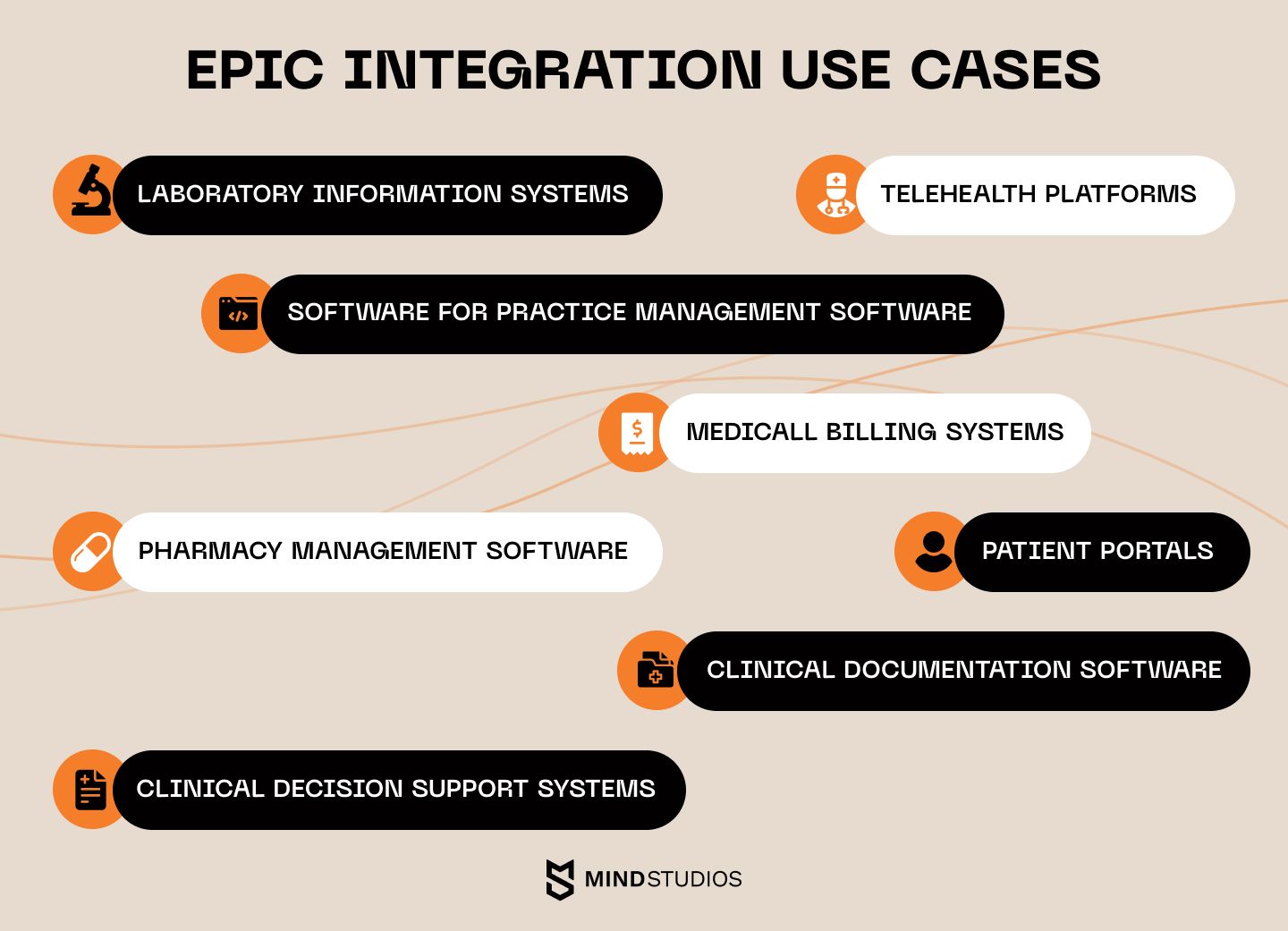
In case you work with any of the systems mentioned above and want to explore how Epic EHR API integration or EMR implementation can benefit your operations — reach out, and we’ll help you explore the question.
Conclusion
Epic is steadily conquering the healthcare software market, and we can see why. Its comprehensive, customizable, and interoperable EHR/EMR solutions help enhance patient care, streamline clinical operations, and support data exchange across diverse healthcare settings. In fact, when we at Mind Studios build telehealth or other medical solutions for our clients, we also go for Epic integration as the most convenient and efficient option.
Integrating EHR and EMR systems can be a complex and overwhelming process, especially in the beginning. However, you can start small with a free consultation from Mind Studios. Our business development team is happy to guide you through different integration options for your specific project and develop a strategy that fits your organizational needs and resources perfectly.

